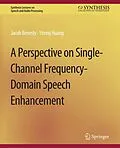This book focuses on a class of single-channel noise reduction methods that are performed in the frequency domain via the short-time Fourier transform (STFT). The simplicity and relative effectiveness of this class of approaches make them the dominant choice in practical systems. Even though many popular algorithms have been proposed through more than four decades of continuous research, there are a number of critical areas where our understanding and capabilities still remain quite rudimentary, especially with respect to the relationship between noise reduction and speech distortion. All existing frequency-domain algorithms, no matter how they are developed, have one feature in common: the solution is eventually expressed as a gain function applied to the STFT of the noisy signal only in the current frame. As a result, the narrowband signal-to-noise ratio (SNR) cannot be improved, and any gains achieved in noise reduction on the fullband basis come with a price to pay, which is speech distortion. In this book, we present a new perspective on the problem by exploiting the difference between speech and typical noise in circularity and interframe self-correlation, which were ignored in the past. By gathering the STFT of the microphone signal of the current frame, its complex conjugate, and the STFTs in the previous frames, we construct several new, multiple-observation signal models similar to a microphone array system: there are multiple noisy speech observations, and their speech components are correlated but not completely coherent while their noise components are presumably uncorrelated. Therefore, the multichannel Wiener filter and the minimum variance distortionless response (MVDR) filter that were usually associated with microphone arrays will be developed for single-channel noise reduction in this book. This might instigate a paradigm shift geared toward speech distortionless noise reduction techniques. Table of Contents: Introduction / Problem Formulation / Performance Measures / Linear and Widely Linear Models / Optimal Filters with Model 1 / Optimal Filters with Model 2 / Optimal Filters with Model 3 / Optimal Filters with Model 4 / Experimental Study
Autorentext
Jacob Benesty received his Ph.D. degree in control and signal processing from Orsay University, France, in April 1991. During his Ph.D. (from Nov. 1989 to Apr. 1991), he worked on adaptive filters and fast algorithms at the Centre National d'Etudes des Telecomunications (CNET), Paris, France. From January 1994 to July 1995, he worked at Telecom Paris University on multichannel adaptive filters and acoustic echo cancellation. From October 1995 to May 2003, he was first a Consultant and then a Member of the Technical Staff at Bell Laboratories, Murray Hill, NJ, USA. In May 2003, he joined the University of Quebec, INRS-EMT, in Montreal, Quebec, Canada, as a Professor. His research interests are in signal processing, acoustic signal processing, and multimedia communications. He is the inventor of many important technologies. In particular, he was the lead researcher at Bell Labs who conceived and designed the world-first, real-time, hands-free, full-duplex stereophonic teleconferencing system. Also, he and Tomas Gaensler conceived and designed the world-first, PC-based, multi-party hands-free, full-duplex stereo conferencing system over IP networks. He is the editor of the book series: Springer Topics in Signal Processing. He has co-authored and co-edited many books in the area of acoustic signal processing. He is also the editor-in-chief of the reference Springer Handbook of Speech Processing (Berlin: Springer-Verlag, 2007).
